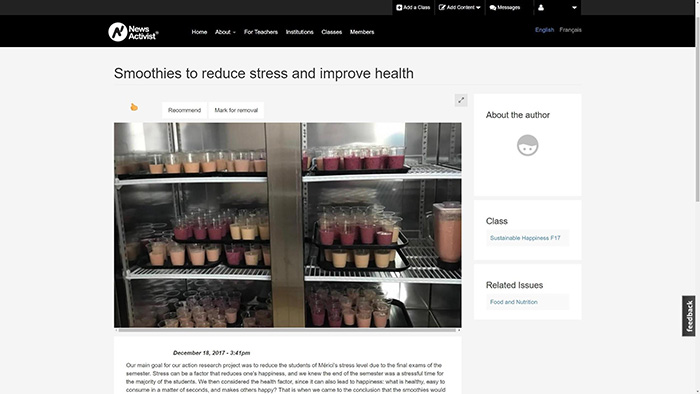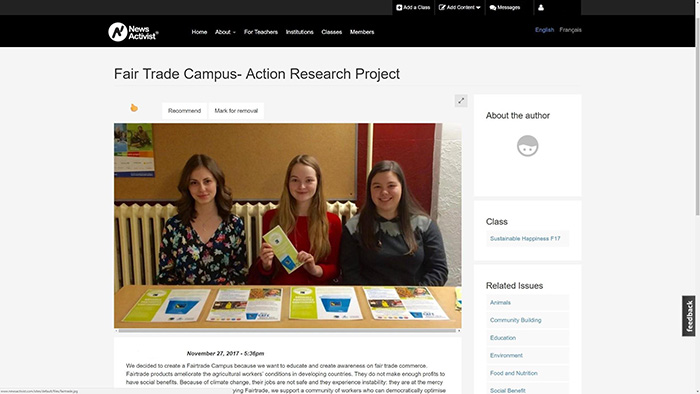Action Research in Action
Before beginning, let us start at the end. By mid-December 2017, more than 140 students attending 3 colleges had completed 45 action research projects, and in doing so had made a positive contribution to their communities, all the while sharing their experiences with each other, from planning to implementation, using an online platform. All the projects were made possible through the funding provided by ECQ (Entente-Canada Québec).
Some of the highlights
A team at Collège Mérici organized a blood donation day on campus with Héma-Québec.
It’s easy to be motivated. It’s more important than a school project.

Students organized a blood donation day on campus
A team at Collège Laflèche developed a new marketing package for The Lotus House, a hybrid of a guesthouse and orphanage in Ulaanbaatar, Mongolia.
The project evoked a strong sense of satisfaction, pride, and responsibility in my students who were able to connect with a lifestyle and landscape which was completely foreign to them. They were also able to apply their personal talents and professional abilities in order to make concrete and useful suggestions.
A team at Champlain College St-Lambert built a mason bee house and wrote a letter to the mayor of St. Amable encouraging the municipality to join in Montreal’s initiative to become more pollinator friendly.
Why do I like this project? They were engaged in a way that I rarely see. And, they tried to make me a bee house as a present. On a personal level, that’s hard to beat.
Building on the efforts of projects done in the winter and fall semesters of 2016, a team created a green wall in the library at Champlain College St-Lambert.
The benefits of the project were not merely theoretical and limited to the students at hand, but are felt by everyone who uses the library. Moreover, there are still numerous possibilities to expand the green wall and even create new ones in other spaces in the library or around campus.
A team at Collège Mérici organized a food collect, including unwanted food from grocery stores, and stocked the community refrigerator in the St. Roch district of Québec City.
The students knew they were doing something good. The projects are concrete, and the students know they can have a positive impact on their community.
“If I have seen further, it is by standing on the shoulders of giants.”
Like every story, this one does indeed have a beginning. For me, in the fall of 2017, there are 2 giants on whose shoulders we stood. The first is Susan MacNeil, an ESL teacher and now retired colleague of mine. Funded by ECQ, Susan with Gina Lavigne at Collège Laflèche led a series of projects, the goal of which was to foster links between English and French-speaking colleges by building an online community. In 2016, this included the notion of action research, and this is where Chris Adam (our second giant) at Dawson College entered the picture. Chris acted as a consultant in the winter of 2016, coaching us on using action research in the classroom, and again in 2017.
This brings us to the fall of 2017; again funded by ECQ we combined the building of an online community with action research, this time with the projects focusing on the promotion of sustainable development and well-being.
“And… Action!”
So, what exactly is an action research project? Essentially, it is the use of real-life problem solving skills and is possible in a wide range of disciplines as the projects can be linked to the content of most courses. The process of doing action research can be divided into 6 steps.
- Explore the problem: The first step is for each group to identify a problem, linked to the subject matter of the class. For example, for my elective class titled Sustainable Happiness, which combines notions of sustainable development and positive psychology, the target was easy: we need to make people on campus happier. This led a number of groups to identify the rising stress level at the end of the semester as a problem worth solving.
- Explore possible solutions: Teams brainstorm possible solutions and explore the feasibility of each. Taking the example of stress, solutions included acts of altruism, mindfulness workshops, and physical activity. The feasibility often depends on the administrative structure at a college, which presents a good opportunity to practice mindfulness!
- Identify the solution: The conclusion of the previous step; I meet with each team at this point to plan the next step.
- Design the action plan: The groups plan their action, which includes drawing up a timetable and sharing the workload between team members. Projects can require that the students identify stakeholders, secure the requisite permissions, make reservations, establish a budget, produce publicity etc. All of this appears on the plan. The action plan for a group who wanted to secure the Fairtrade Campus certification for our college involved approaching and persuading a number of stakeholders: the teachers’ coffee club, the teaching restaurant, the college-run coffee machines, and the catering company that runs our cafeteria. They also had to plan an awareness campaign involving an information stand and a poster campaign, which required the permission of the building management committee. It is at this point that many of us included a graded element. For example, in Sustainable Happiness, students had to produce a proposal including steps 1 to 3 and a detailed plan. This also gives me the opportunity to validate their propositions and test the water with the various levels of administration (“I have a group of students who will come to see you about…”).
- Implement the action plan: This is when the students meet and persuade the stakeholders, make the smoothies, sell the spider plants, launch their publicity campaign, collect signatures etc.
- Evaluate the action plan/action: This step varies depending on the class. For example, in Sustainable Happiness, my students wrote an analysis of the impact of their action on the community and on themselves, integrating the notions of happiness and well-being seen in class. In the ESL classes, the oral and/or written production based on the action were assessed.
Throughout the semester, an online community was created as at various stages students posted about their projects on a blog-style platform, www.newsactivist.com, and commented on other projects. For example, in my class, the students posted about the problem they had identified and their proposed solution (steps 1 to 3). They then posted a description of the “action in action” (step 5).

The students posted about the problem they had identified and their proposed solution
These requirements were similar across all the classes involved in the project. The possibility of sharing their work with an online community, including students at other colleges, helped with inspiration and motivation as well as increasing the sense of achievement.
“Yes We Can”
Our students are empowered through action research as they are responsible for making a positive change in their community, and they see that they “can”. The projects also tend to include many different people at a college: the librarian, the building manager, the people working at the cafeteria etc., which helps build a sense of community, thereby adding to their significance. For example, at the blood collect, all the directors at Collège Mérici gave blood and got to talk with the students who had organized it. How often do our students have this opportunity? Finally, as a teacher, I find action research so rewarding, with my students taking me to places I would never have imagined: “You want to bake 300 cookies and give them out for free?” “You want to invite Pierre Lavoie to college to give a conference and organize a sponsored race?” “You want people to give blood?” “OK…yes we can!”

Students are empowered through action research as they are responsible for making a positive change in their community.

